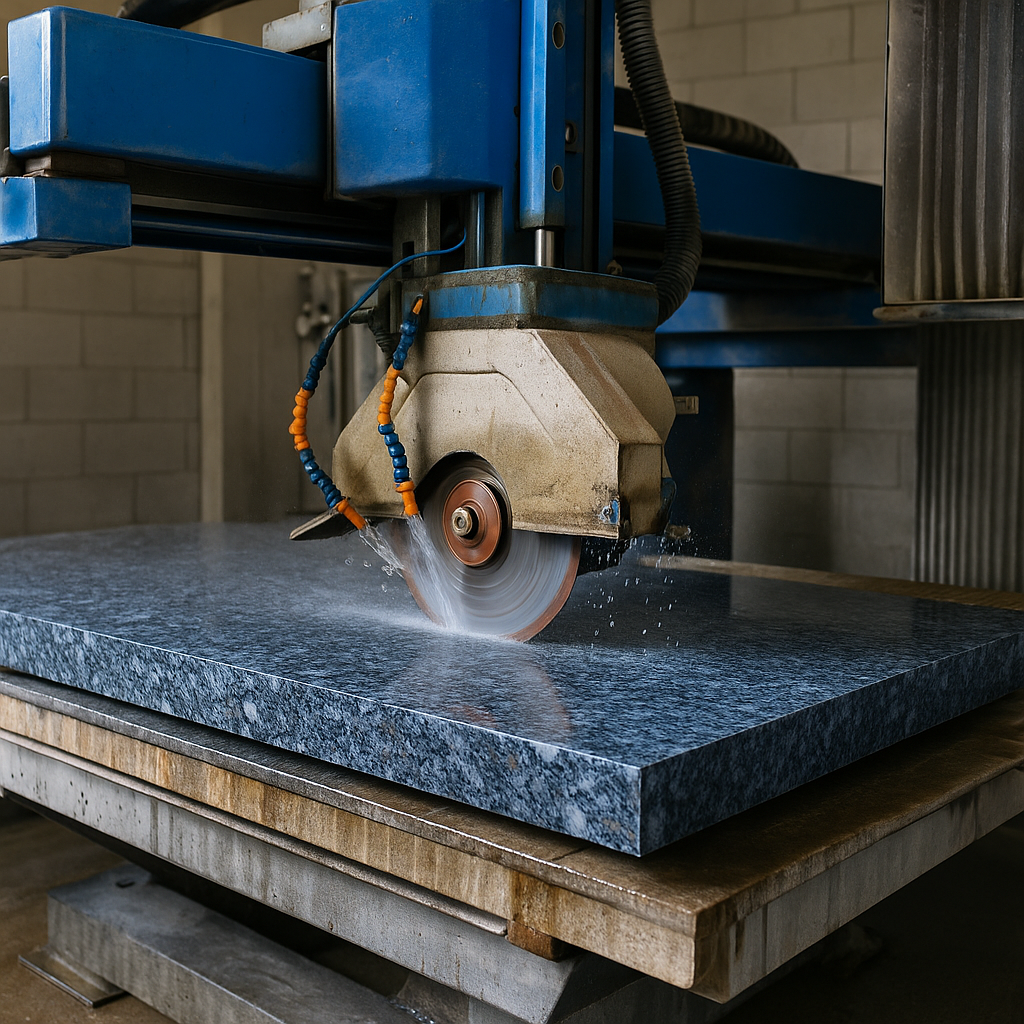
Granite is one of the most durable and elegant natural stones used in modern construction.
Granite is one of the most durable and elegant natural stones used in modern construction. From premium kitchen countertops and architectural facades to statement floors and custom furnishings, granite is prized for its strength and aesthetic appeal. However, these qualities also make it challenging to cut precisely. That’s where specialized granite cutting machines come in.
Modern fabrication relies on technology to ensure that every granite slab is cut cleanly, consistently, and with minimal waste. In this article, we explore how advanced machines like bridge saws, CNC routers, and waterjet cutters dramatically improve the quality of granite cuts, helping to reduce installation time, enhance design precision, and improve overall performance.

Why Precision Matters When Cutting Granite
Granite is an igneous rock composed of interlocking mineral crystals—mainly quartz, feldspar, and mica. While this composition gives it excellent strength, it also makes it prone to chipping, cracking, and microfractures if not cut correctly.
Cut quality affects:
- Visual aesthetics (seamless edges, aligned veins)
- Ease of installation
- Maintenance and repair needs
- Material waste and overall cost
Using specialized machines helps address all these areas, offering consistency that hand tools or general-purpose equipment can’t achieve.
Types of Machines That Improve Granite Cut Quality
Modern granite fabrication involves a suite of high-performance machines, each serving a specific function—from rough slab separation to detailed edge profiling and polishing.
1. Bridge Saws
Bridge saws use diamond-tipped circular blades mounted on a motorized bridge to make straight, high-speed cuts. These machines provide consistent results for large slab work and are ideal for cutting countertops or tiles with straight lines.
2. CNC Routers
Computer Numerical Control (CNC) routers automate cutting processes for complex shapes and precision edge profiles. CNC technology is especially valuable in high-end custom granite installations.
3. Waterjet Cutters
Waterjet machines cut granite using high-pressure water mixed with abrasive materials. This cold-cutting method eliminates the risk of thermal cracks and allows fine detail cutting for artistic or intricate projects.
🔧 Learn more about the difference between cutting methods:
✅ How do granite cut methods differ diamond blade, waterjet, CNC?
Key Benefits of Specialized Cutting Machines
1. Improved Edge Precision
High-end machines can produce flawlessly straight or curved edges that require little to no polishing afterward. CNC routers, in particular, can shape decorative edge profiles like ogee, bevel, or bullnose with remarkable precision.
2. Minimal Chipping and Fractures
Machines with vibration-dampening features and water cooling reduce the risk of stress fractures and chipping. Wet cutting techniques also help by keeping the stone cool and lubricated during cutting.
💧 Curious how dry and wet techniques compare?
✅ How Do Cry and Wet Granite Cutting Techniques Compare?
3. Consistent Cut Depth and Angle
Unlike manual methods, machines maintain consistent blade angle and cutting depth across the slab, ensuring uniformity in thickness—crucial when aligning multiple granite pieces during countertop installation or tile layout.
4. Reduced Material Waste
Precision means fewer errors, and fewer errors mean less waste. Especially with expensive or rare granite slab colors, reducing offcuts and rejected pieces directly improves cost-efficiency.
5. Enhanced Safety
Advanced machines are often enclosed or feature dust suppression systems, reducing the operator’s exposure to harmful silica dust. CNC and waterjet systems also require less manual handling, lowering injury risk.
Applications That Require High-Quality Granite Cuts
✅ Kitchen Countertops
Clean edge finishes and precise sink or faucet cutouts are essential. Machines help match patterns across seams and make installation smoother.
✅ Granite Wall Panels and Flooring
Large-format granite requires straight, uniform cuts to ensure perfect alignment. Inconsistent cutting can lead to noticeable gaps and uneven seams.
✅ Custom Furniture and Art Pieces
High-end furniture, sculptures, and inlays often require CNC or waterjet cutting for detailed designs that would be impossible to achieve manually.
✅ Architectural Features
Columns, fireplace surrounds, staircases, and granite design ideas like waterfalls or curved counters benefit from the multi-axis capability of modern machines.
Machine-Aided Polishing and Finishing
After the primary cut, automated polishing machines enhance the surface finish, whether it’s glossy, honed, or leathered. These machines:
- Eliminate blade marks
- Smooth out minor chips
- Prepare the surface for sealing
Proper finishing extends the stone’s life and enhances its appearance, reducing the need for frequent granite countertop repair.
How Machines Affect Installation Time and Cost
The efficiency and accuracy of machine cutting directly influence the time and cost of granite installation:
| Factor | Manual Cutting | Specialized Machines |
|---|---|---|
| Cut accuracy | Moderate | High |
| Rework required | Frequent | Minimal |
| Labor time | High | Lower |
| Material waste | Higher | Reduced |
| Final polish | Often needed | Often unnecessary |
Machine-cut granite pieces fit better, seal more effectively, and reduce overall project delays.
Choosing the Right Cutting Technology Based on Granite Type
Different types of granite (natural vs. engineered, light vs. dark, coarse vs. fine-grained) require different cutting approaches:
- Harder granite varieties may benefit from waterjet or wire saw cutting.
- Artificial granite often responds well to CNC or dry cutting.
- Highly decorative granites (with lots of veining) need careful planning and CNC layout to preserve design continuity.
Clean and Maintain Granite More Easily After Machine Cuts
Machine-cut granite results in:
- Tighter seams
- Smoother finishes
- Easier cleaning (less porous edges)
- Lower chance of surface imperfections that trap debris
This reduces the burden of clean granite maintenance over time and keeps surfaces looking new.
Final Thoughts
Modern granite cutting machines play a crucial role in ensuring the beauty, integrity, and durability of granite installations. From CNC routers and bridge saws to waterjet and edge polishers, each machine contributes to improving accuracy, safety, efficiency, and aesthetic quality.
By leveraging specialized tools, fabricators can offer high-end results with less waste, faster turnaround, and fewer post-installation issues. Whether you’re working with natural granite or engineered stone, machine cutting is the key to unlocking its full potential.

